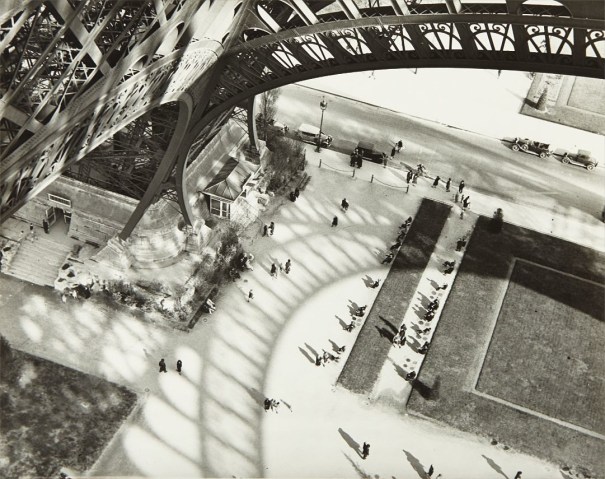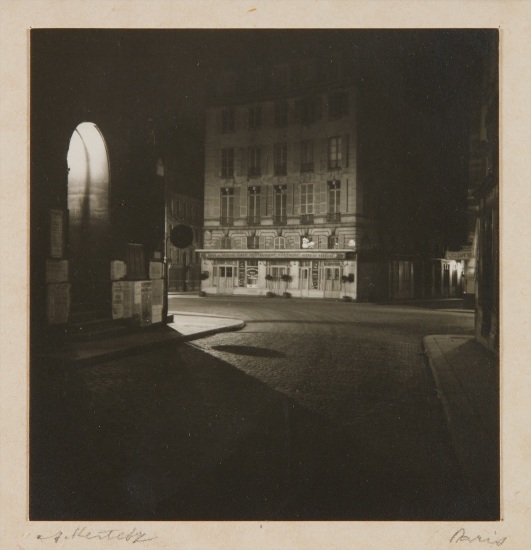André Kertész Untitled (Distortion #167) 1933 Gelatin silver print. 9 1/4 x 6 1/2 in. (23.5 x 16.5 cm) Initialed, numbered '167' in pencil and '32 bis, Rue du Cotentin, Paris-XV' copyright credit stamp on the verso.
Provenance Estate of the photographer via Susan Harder and Edwynn Houk Gallery, 1986 Gift of an East Coast Collector, 1986 Literature Borhan, André Kertész His Life and Work, p. 204 National Gallery of Art, Washington, André Kertész pl. 71 The Art Institute of Chicago/ The Metropolitan Museum of Art/ Thames & Hudson, André Kertész Of Paris and New York, p. 191 Catalogue Essay As an early champion of André Kertész’s work, the Art Institute of Chicago was the first museum in America to give the Hungarian-born French photographer a solo exhibition, in 1946. The exhibition marked a high point in Kertész’s new American life. Although he had achieved acclaim in Paris for his new vision in the press, and was known in artist circles, it was not until the 1960’s, when Kertész was past seventy years old, that his work received full recognition in the world of fine art. In 1985, nearly 40 years after his first exhibition, the Art Institute of Chicago further solidified Kertész’s place in history as a key figure in modern photography with the traveling retrospective exhibition André Kertész Of Paris and New York. Originating in a request for photographs of female nudes by the Parisian men’s magazine Le Sourire (The Smile) in 1933, Kertész’s Distortion images are today considered a cornerstone of European photography between the wars. The photographer had been thinking for years to photograph the human body as a “grotesque,” and had tested his idea with a friend, Carlo Rim, already in 1930. In response to the assignment from Le Sourire, Kertész held eight different sessions over a four-week period with two hired models, Najinskaya Verackhatz and Nadia Kasine, whom he posed with a combination of fun-house mirrors to make more than 200 Distortion negatives. Captions for the twelve images published by the magazine on March 2, 1933 stressed relationships between these morphed bodies and those in contemporary painting and sculpture. Kertész returned several times to the Distortions in the course of his career, beginning with his first solo gallery show in the States, held in New York at the PM Gallery in 1937. (That same year, Beaumont Newhall included Distortions in his landmark History of Photography exhibition at The Museum of Modern Art.) The fluid image of a female nude in Kertész’s Distortion #167 cascades down the center of the picture frame: starting with the fullness of the upper body, narrowing between the elbows and then pooling into a v-shaped confine before continuing into the elongated hands and then dropping off the picture plane at the knees. Lot 41 and the Distortion prints being offered in lots 42 & 44 are prints Kertész made between the early months of 1933, shortly after he took the negatives, and 1936, when he left Paris for New York. Most have his 1931-1936 Parisian studio stamp on the verso and all are printed on a single weight warm toned glossy paper, trimmed with no margins. The majority of these prints were part of a large group that was donated to the Art Institute of Chicago following the major 1985 retrospective. Read More
André Kertész Untitled (Distortion #167) 1933 Gelatin silver print. 9 1/4 x 6 1/2 in. (23.5 x 16.5 cm) Initialed, numbered '167' in pencil and '32 bis, Rue du Cotentin, Paris-XV' copyright credit stamp on the verso.
Provenance Estate of the photographer via Susan Harder and Edwynn Houk Gallery, 1986 Gift of an East Coast Collector, 1986 Literature Borhan, André Kertész His Life and Work, p. 204 National Gallery of Art, Washington, André Kertész pl. 71 The Art Institute of Chicago/ The Metropolitan Museum of Art/ Thames & Hudson, André Kertész Of Paris and New York, p. 191 Catalogue Essay As an early champion of André Kertész’s work, the Art Institute of Chicago was the first museum in America to give the Hungarian-born French photographer a solo exhibition, in 1946. The exhibition marked a high point in Kertész’s new American life. Although he had achieved acclaim in Paris for his new vision in the press, and was known in artist circles, it was not until the 1960’s, when Kertész was past seventy years old, that his work received full recognition in the world of fine art. In 1985, nearly 40 years after his first exhibition, the Art Institute of Chicago further solidified Kertész’s place in history as a key figure in modern photography with the traveling retrospective exhibition André Kertész Of Paris and New York. Originating in a request for photographs of female nudes by the Parisian men’s magazine Le Sourire (The Smile) in 1933, Kertész’s Distortion images are today considered a cornerstone of European photography between the wars. The photographer had been thinking for years to photograph the human body as a “grotesque,” and had tested his idea with a friend, Carlo Rim, already in 1930. In response to the assignment from Le Sourire, Kertész held eight different sessions over a four-week period with two hired models, Najinskaya Verackhatz and Nadia Kasine, whom he posed with a combination of fun-house mirrors to make more than 200 Distortion negatives. Captions for the twelve images published by the magazine on March 2, 1933 stressed relationships between these morphed bodies and those in contemporary painting and sculpture. Kertész returned several times to the Distortions in the course of his career, beginning with his first solo gallery show in the States, held in New York at the PM Gallery in 1937. (That same year, Beaumont Newhall included Distortions in his landmark History of Photography exhibition at The Museum of Modern Art.) The fluid image of a female nude in Kertész’s Distortion #167 cascades down the center of the picture frame: starting with the fullness of the upper body, narrowing between the elbows and then pooling into a v-shaped confine before continuing into the elongated hands and then dropping off the picture plane at the knees. Lot 41 and the Distortion prints being offered in lots 42 & 44 are prints Kertész made between the early months of 1933, shortly after he took the negatives, and 1936, when he left Paris for New York. Most have his 1931-1936 Parisian studio stamp on the verso and all are printed on a single weight warm toned glossy paper, trimmed with no margins. The majority of these prints were part of a large group that was donated to the Art Institute of Chicago following the major 1985 retrospective. Read More




.jpg)

Testen Sie LotSearch und seine Premium-Features 7 Tage - ohne Kosten!
Lassen Sie sich automatisch über neue Objekte in kommenden Auktionen benachrichtigen.
Suchauftrag anlegen